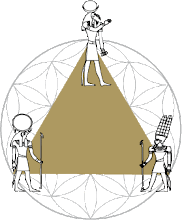Whilst staying at Aswan we took a short journey to the banks of Lake Nasser and a motor boat trip across to a small granite island that rises out of the water with Kalabsha temple at its peak. Together with other monuments it had been rescued and rebuilt to save them from the rising Nile waters created by the construction of Aswan's High Dam.
There is something unique and wonderful about this small island with its winding cobbled pathways that lead to different monuments, the sun beats down and diamonds flash across the turquoise crystal waters surrounding the island, the wind enlivens your senses, and here I found myself initially drawn to the glorious little kiosk of Kertassi that stands proudly on the edge of the rocks looking out over Lake Nasser, the kiosk basked in the warmth and brilliance of the Egyptian sun, to the glory of the Goddess Hathor whose warm smile greets you from two of the columns, and welcomes you within her Kiosk, here I experienced a wonderful feeling of love, a blessing from Hathor herself, so I rested and found myself considering the course of my life all the twists and turns and how it had taken me on this path to Egypt. As I rested I felt the warmth of Light energy infuse my body, offering me new light energy and inspiration and so I followed the path to the next monument on the island which is known as Gerf Hussein, the Egyptians knew it as Per Ptah, the "House of Ptah", it was created in the style of Abu Simbel and was originally rock cut with an inner chamber, and was created for Ramses the great by Setaw who was the viceroy of Nubia. Here on the island all that remains are statues of the outer courtyard, which I felt were the oddest looking statues I have ever seen of Ramses, they are short and dumpy and totally lacking in the usual elegant style of ancient Egyptian statues, so I continued on my way and followed the cobbled path back to the side of the main temple where I passed an interesting and unexpected collection of rocks that were created during the Neolithic period, with sketches of animals racing across the desert during a hunt. The path rose and swerved around the back of the main temple around the island until I arrived at another small monument known as Beit al-Wali, which means House of the Govenor, which was created by the viceroy for Ramses the great. I entered a small enclosed forecourt , and on the walls the small reliefs enact fighting scenes with Syrian and Libyan on the right side, Ethiopians on the left. Ramses grips the hair of his enemies whilst women plead for mercy. Entering Inside the small chamber there are two columns, behind me I saw Ramses gripping the hair of his enemy ready to smash his skull, then he calmly offers gifts to the gods. Two small niches are cut into the facing wall and have three seated statues inside them, here Anukis wears a large plumed headdress, in Egyptian mythology this goddess was the personification of the River Nile, and so we find here where the Nile starts its journey through Egypt. Her name means the Embracer, her bounty flooded the fields nourishing them and bringing new life.
Saturday, 5 February 2011
Subscribe to:
Post Comments (Atom)

No comments:
Post a Comment